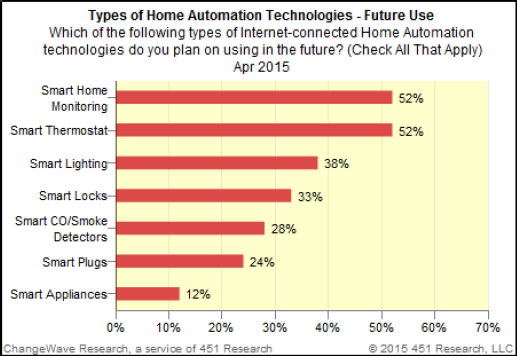A report by ChangeWave Research, a service of 451 Research, finds that the outlook is bright for home automation technology. Similarly, our M&A KnowledgeBase has seen significant acquisition activity in that space as well as the broader Internet of Things (IoT) arena. As a result, we expect increased interest in IoT and connected homes, both for consumers and tech dealmakers.
According to a recent ChangeWave survey of 2,152 consumers, more than half said they plan to use smart thermostats and home monitoring in the future. Other home automation technologies such as smart lighting and locks are also expected to see increased use down the road.
The survey found Nest Labs to be the second-most-popular smart thermostat manufacturer, behind Honeywell. Nest and parent company Google have been the most-active acquirers in home automation – since the start of 2014, Google has spent more than $3.7bn on the connected home, starting with its reach for Nest and then Nest’s purchases of Dropcam and Revolv. Other acquirers in the home automation space have included Silicon Labs and British Gas, which bought connected home devices and monitoring software, respectively.
From a broader perspective, the IoT sector has seen record-breaking M&A activity. Buyers this year have inked 39 IoT acquisitions for $14.8bn, which surpasses the $14.3bn deal value for IoT transactions in all of last year. Semiconductor deals have driven the bulk of spending thus far this year, with ARM, Intel and NXP Semiconductors each announcing two or more IoT-focused purchases.


Hi Mark,
To the best of your knowledge, what does “smart home monitoring” refers to? Security?
Hi — sorry it’s taken so long to get back to you (WordPress got a bit overwhelmed by spam bots.)
To (finally) answer your question: for ‘smart home monitoring’, think cameras, motion sensors and similar devices that allow users to remotely see what’s going on back at home. (For ex, DropCam.) It is primarily, but not exclusively, security. As a reminder, it was tied for top-ranked choice, with slightly more than half of our respondents indicating they planned to use it.
Hope that helps.
regards,
Brenon